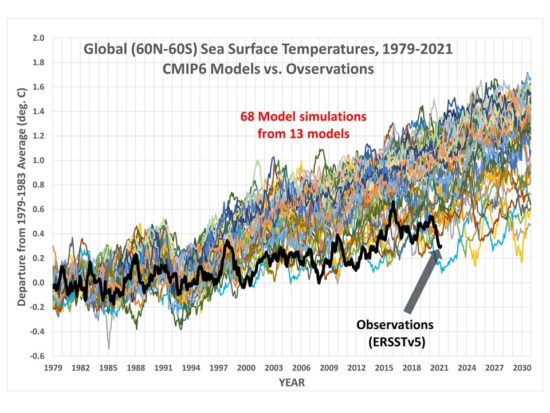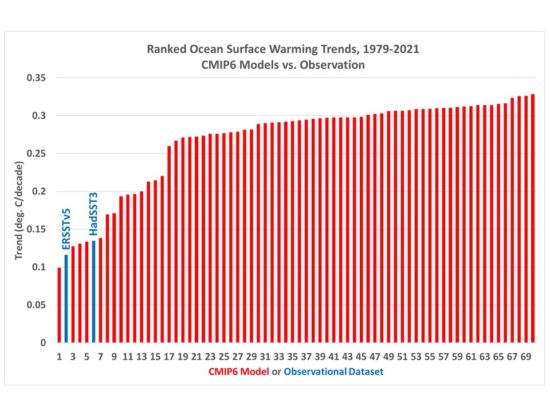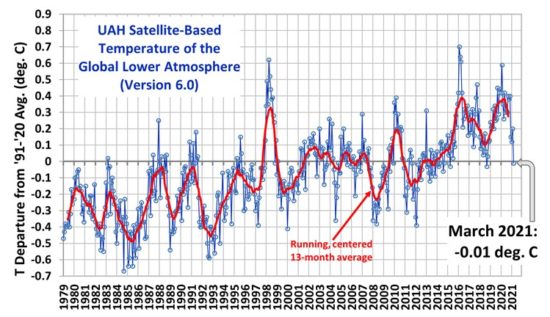The claim by the Biden Administration that climate change has placed us in a moment of “profound crisis” ignores the fact that the energy policy changes being promoted are based upon computer model simulations which have produced average warming rates at least DOUBLE those observed in the last 40+ years.
Just about every climate claim made by politicians, and even many vocal scientists, has been either an exaggeration or a lie.
While it is easy for detractors of what I will show to claim I am in the scientific minority (true), or that I am a climate denier (not true; I do not deny some level of human-caused warming), the fact is that the “official” observations in recent decades are in disagreement with the “official” climate models being promoted for the purposes of implementing expensive, economically-damaging, and poverty-worsening energy policies.
Global Ocean Temperatures are Warming at Only ~50% the Rate of Climate Model Projections
Today’s example comes from global-average sea surface temperatures. The oceans provide our best gauge of how fast extra energy is accumulating in the climate system. Since John Christy and I are working on a project that explains global ocean temperatures since the late 1800s with a 1D climate model, I thought I would show you just how the observations are comparing to climate models simulations.
The plot below (Fig. 1) shows the monthly global (60N-60S) average ocean surface temperature variations since 1979 for 68 model simulations from 13 different climate models. The 42 years of observations we now have since 1979 (bold black line) shows that warming is occurring much more slowly than the average climate model says it should have.

Fig. 1. 68 CMIP6 climate model simulations of global average sea surface temperature (relative to the 5 year average, 1979-1983), and compared to observations from the ERSSTv5 dataset.
In terms of the linear temperature trends since 1979, Fig. 2 shows that 2 of the top-cited ocean temperature datasets have warming trends near the bottom of the range of climate model simulations.

Fig. 2. Linear temperature trends, 1979-2020, for the various model and observational datasets in Fig. 1, plus the HadSST3 observational record.
Deep Ocean Warming Could Be Mostly Natural
A related issue is how much the deep oceans are warming. As I have mentioned before, the (inarguable) energy imbalance associated with deep-ocean warming in recent decades is only about 1 part (less than 1 Watt per sq. m) in 300 of the natural energy flows in the climate system.
This is a very tiny energy imbalance in the climate system. We know NONE of the natural energy flows to that level of accuracy.
What that means is that global warming could be mostly natural, and we would not even know it.
I’m not claiming that is the case. I am merely pointing out the level of faith that is involved in the adjustments made to climate models, which necessarily produce warming due to increasing CO2 because those models simply assume that there is no other source of warming.
Yes, more CO2 must produce some warming. But the amount of warming makes all the difference to global energy policies.
Seldom is the public ever informed of these glaring discrepancies between basic science and what politicians and pop-scientists tell us.
Why does it matter?
It matters because there is no Climate Crisis. There is no Climate Emergency.
Yes, irregular warming is occurring. Yes, it is at least partly due to human greenhouse gas emissions. But seldom are the benefits of a somewhat warmer climate system mentioned, or the benefits of more CO2 in the atmosphere (which is required for life on Earth to exist).
But if we waste trillions of dollars (that’s just here in the U.S. — meanwhile, China will always do what is in the best interests of China) then that is trillions of dollars not available for the real necessities of life.
Prosperity will suffer, and for no good reason.

 Home/Blog
Home/Blog




